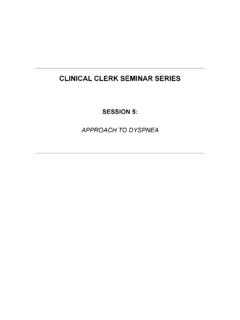Transcription of ANIMAL ANESTHESIA MONITORING GUIDELINES
1 1 ANIMAL ANESTHESIA MONITORING GUIDELINES 2 ECG MONITORING REASONS FOR MONITORING ECG Diagnosing arrhythmias or conduction abnormalities As part of preoperative work-up in senior patients Routine or indicated screens During surgery and to evaluate effects of cardiac drugs Assess patients with breathing problems or that are in shock Assess patients with cardiac murmurs To help decide on further diagnostic tests (thoracic radiography or echocardiography) Periodic assessments of arrhythmia prone breeds - Boxers (myocarditis), - Doberman pinschers (ventricular arrhythmias or cardiomyopathy), - German shepherds (congenital ventricular arrhythmias), and - Miniature schnauzers (sick sinus syndrome and sinus arrest/block) 3 ECG TECHNIQUE For veterinary patients, especially small ones, following the tips below will allow for the optimal measurement of ECG.
2 Place ANIMAL in right lateral recumbence Hair should not be clipped over lead site. If matted, only lightly clip, but not down to skin Prepare the lead sites w/ alcohol first, then apply ultrasound gel or KY jelly if desired. Caution: ECG paste may corrode metal skin clips For cats, place a thin layer of alcohol-saturated cotton over site, apply gel and attach skin clips Do not allow the metal clips to come in contact with metal (each other, metal exam table, etc) Increase GAIN setting on monitor for small complexes Insure that skin clips have adequate spring tension If electrical interference is encountered move electrical equipment away from the monitor and check ECG filter setting on monitor (High or Low) Note.
3 Operating monitor with battery will reduce interference 4 SETTING UP ECG LEADS Prepare site with alcohol Use figures below for lead selection Connect lead wires to patient cable Connect patient cable to monitor Turn monitor on Metal clips must not contact metal table or each other Note: LA above is reference electrode. Reference electrode can also be placed on right hind leg. This electrode is Green in USA standard 5 TEMPERATURE MONITORING Better temperature management was cited as one of the three major factors in improving general ANESTHESIA mortality rates.
4 During ANESTHESIA , hypothermia is a frequent, serious risk, although hyperthermia is also a risk in some Nordic breeds ADVERSE EFFECTS OF HYPOTHERMIA Immune system depression; triple the post-operative infection rate Coagulopathy and increased blood viscosity leading to sludging Increased systemic vascular resistance and afterload Hypocapnia that may lead to alkalemia if positive pressure ventilation is not adjusted Physiologic response to hypoxemia and hypercarbia is blunted Effect on central nervous system delays recovery and causes confusion, stupor or coma Hypovolemia and/or hyperglycemia Minimum alveolar concentration decreases 5%/C below normal.
5 Anesthetic overdose may occur Delayed drug metabolism, decreased liver metabolism leading to drug toxicity Post operative shivering increases intraocular pressure, intracranial pressure and wound pain 6 ANIMAL blood PRESSURE MONITORING DURING SURGERY Assess anesthetic depth* Monitor trends to provide: - an index of a patient s cardiovascular status - the depth of ANESTHESIA - response to therapeutic intervention - an indication for adjusting fluid therapy, and - titrating drug doses.
6 Monitor adequacy of circulation Discover hypotension* (SAP<80mmHg; MAP<60mmHg) Use MAP for the best determinant of good organ perfusion Monitor the effect of pre-anesthetic agents that can cause hypotension* Compare SAP to normal intraoperative pressure between 110-160mmHg. Detect inadequate ANESTHESIA and resulting pain by increase in heart rate * Studies have shown that >25% of surgery patients are hypotensive and that hypotension is a major risk factor in 1 year post-surgery mortality IN THE EXAM ROOM HYPERTENSION Suspected if systolic pressure >150 mmHg Confirmed if systolic >160 mmHg.
7 Or Diastolic >100 mmHg 60-70% of animals w/renal disease are hypertensive Hypertension often accompanies hyperthyroidism blood pressures rise slowly but steadily with age Overweight animals have higher blood pressures Baseline BP should be established (annual/semi-annual) 7 AIRWAY C02 CAPNOGRAPHY Capnography: The ANESTHESIA Disaster Early Warning System Because all three components of respiration (metabolism, transport, and ventilation) are involved in the appearance of CO2 in exhaled gas, capnography gives an excellent picture of the respiratory process.
8 Nicknamed the ANESTHESIA Disaster Early Warning System, it is greatly responsible for the reduction in death rates during general ANESTHESIA in human medicine from 1 in 5,000 in 1983 to 1 in 300,000 in 2005. Factors that affect CO2 Metabolism - Substrate metabolism, drug therapy, and core temperature Transport - Cardiac output and pulmonary perfusion. Ventilation - Obstructive and restrictive diseases, and breath rate Ventilation/Perfusion ratios - Shunt perfusion and dead space ventilation ANIMAL C02 monitors provide digital read out of end-tidal CO2 only or with a waveform (capnograph).
9 The digital read out of ETCO2 can be in mm Hg (partial pressure of CO2 in exhaled gas) or as % in exhaled gas. Most of the commonly used devices use infra red absorption of CO2 as principle of operation. 8 Capnometry measures the amount of end-tidal (exhaled) carbon dioxide during ventilation. The end-tidal level of carbon dioxide is generally less but is reflective of carbon dioxide in arterial blood and can serve as an indirect noninvasive method of assessing the adequacy ventilation.
10 A more complete picture of carbon dioxide transfer can be obtained from a capnogram, similar to an ECG tracing. A capnogram provides a continuous waveform that reflects the changes in airway carbon dioxide levels throughout inspiration and expiration. In contrast, capnometry simply reports the maximum and minimum carbon dioxide levels associated with expiration and inspiration respectively; similar to the heart rate output from an ECG. Capnography is a useful MONITORING tool in mammals with normal lungs.
